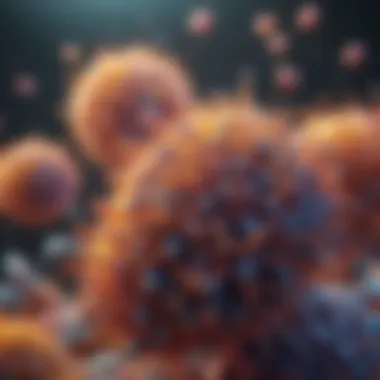Understanding CK1 Kinase's Role in Cellular Biology


Intro
CK1 kinase, a member of the casein kinase family, plays a pivotal role in numerous cellular activities. It is predominantly recognized for its serine/threonine phosphorylation functions. This enzymatic activity is crucial for regulating various signaling pathways that influence cellular health and responses to stressors.
Understanding CK1 kinase is essential for researchers and professionals focusing on cell biology. Its involvement in crucial processes ranges from cell cycle regulation to circadian rhythms, making it a significant area of study in both health and disease contexts.
CK1 kinase is not merely a molecular player; it is a central figure in the intricate web of cellular signaling.
In this examination, we will delve into the structure and functional dynamics of CK1 kinase. We will highlight how it interacts with different cellular components and its regulatory mechanisms. Moreover, we will assess its potential as a therapeutic target, emphasizing its implications in innovative treatment strategies for various diseases.
As we progress, we will focus on the broader research landscape surrounding CK1 kinase and its relevance in contemporary scientific inquiry.
Preamble to CK1 Kinase
CK1 kinase (Casein Kinase 1) is a serine/threonine protein kinase that plays a pivotal role in various cellular functions. Its importance stems from its ability to phosphorylate a wide range of substrates, influencing critical cellular processes such as cell cycle regulation, signal transduction, and even developmental pathways. This article aims to illuminate the multifaceted roles CK1 kinase plays by examining its structure, functional significance, and implications in health and disease. Through this exploration, we emphasize not just the kinase's cellular functions, but also its potential as a therapeutic target in clinical settings.
Definition and Characterization
CK1 kinase, which was first characterized due to its effects on casein proteins in milk, is a family of protein kinases. Multiple isoforms exist, each known to exhibit unique properties and functions depending on the cellular context. The activity of CK1 is regulated through various mechanisms, including phosphorylation and protein interactions, allowing it to modulate diverse cellular activities efficiently. It contributes significantly to the dynamic regulation of signaling networks, thus playing a crucial role not only in normal cellular physiology but also in pathological conditions.
Historical Background
The discovery of CK1 dates back to the early 1970s when it was first isolated from cow's milk. Initial studies focused on its action towards casein, hence its name. Over time, research expanded and revealed the enzyme's importance in many biological processes. Significant advancements were made in understanding its cellular roles, which established CK1's position as a key player in numerous signaling pathways. As studies progressed, it became clear that CK1 was involved in processes from embryonic development to the maintenance of circadian rhythms. The historical context of CK1 kinase allows researchers to appreciate its evolution as an essential component of cellular biology, reflecting the growing understanding of protein kinases in cellular mechanisms.
Structure of CK1 Kinase
Understanding the structure of CK1 kinase is crucial for comprehending its function in cellular biology. The structure directly influences its interaction with substrates and other proteins, which in turn affects signaling pathways and cellular responses. CK1 kinase is a serine/threonine kinase that primarily participates in various phosphorylation processes, impacting a myriad of cellular events. The study of its structure reveals insights necessary for targeted therapeutic strategies that could manipulate its activity, thereby having significant implications in addressing diseases like cancer and neurodegenerative disorders.
Domain Architecture
CK1 kinase consists of multiple structural domains that play vital roles in its enzymatic functions and interactions. The primary domains include the catalytic domain, which is responsible for its kinase activity, and regulatory domains that modulate its activity in response to cellular signals.
- Catalytic Domain:
The catalytic domain is highly conserved across different species, demonstrating robust functionality when phosphorylating target proteins. This domain's stability is essential for CK1 kinase's activity. - Regulatory Domains:
These domains ensure that CK1 kinase can respond appropriately to various cellular conditions. They interact with different partners and can influence the kinase's substrate specificity.
The arrangement of these domains is not only pertinent for understanding CK1's basic biology but also for deciphering how alterations can lead to disease states.
Active Site Configuration
The active site of CK1 kinase is where the phosphorylation reaction occurs, making it a focal point of interest in enzymology. This site is characterized by specific residues that contribute to substrate recognition and catalytic efficiency.
The importance of the active site configuration is driven by the following factors:
- Substrate Specificity: The unique arrangement of amino acids determines which substrates CK1 will phosphorylate.
- Catalytic Efficiency: The spatial orientation of these residues influences how effectively CK1 kinase can transfer a phosphate group to its substrate.
- Drug Targeting: Understanding the active site's structure can guide the development of specific inhibitors. These inhibitors could block activity in pathological conditions, offering a targeted approach to treatment.
In summary, the structural insights into CK1 kinase pave the way for future research and therapeutic advancements. Knowing how to manipulate this structure can lead to innovative treatments for various diseases.
Further exploration into the three-dimensional structures of CK1 and its complexes can reveal more about the dynamics involved in its function, leading to enhanced understanding and potential therapeutic applications. Learn more about CK1 kinase on Wikipedia.
Functional Roles of CK1 Kinase


CK1 kinase plays crucial roles in several fundamental processes within cellular biology. Understanding these roles is essential for appreciating how CK1 kinase contributes to the overall function of cells, and for insights into its potential as a therapeutic target. Here, we will explore the various functions of CK1 kinase, particularly focusing on its regulation of the cell cycle and its influence on signal transduction pathways.
Regulation of the Cell Cycle
CK1 kinase is integral to the proper progression of the cell cycle. This enzyme contributes to the regulation of various checkpoints, ensuring that cells only proceed to the next phase when conditions are favorable.
- G1 Phase Regulation: During the G1 phase, CK1 kinase influences the activity of cyclin-dependent kinases (CDKs), which are pivotal for the transition from G1 to S phase. CK1 kinase phosphorylates specific substrates that modulate CDK activity, preventing premature progression through the cycle.
- G2/M Transition: As cells prepare for mitosis, CK1 kinase plays a role in the G2/M transition. The kinase’s activity ensures that DNA is fully replicated and any damage is repaired before the cell divides. This function is vital for maintaining genomic integrity.
- Mitotic Spindle Formation: CK1 kinase also participates in mitotic spindle assembly. It phosphorylates proteins that are essential for spindle function, thereby contributing to accurate chromosomal segregation.
Overall, CK1 kinase is a key player in cell cycle control. Its precise regulation ensures proper cellular function and highlights the importance of this enzyme in cellular health.
Influence on Signal Transduction Pathways
Another significant role of CK1 kinase is its involvement in various signal transduction pathways. This kinase interacts with a range of signaling molecules, influencing cellular responses to external stimuli.
- Wnt Pathway: CK1 kinase is notably active within the Wnt signaling pathway. It phosphorylates components of this pathway, which helps regulate cell fate, proliferation, and migration. Misregulation of this pathway has been implicated in developmental abnormalities and cancer.
- MAPK Pathway: In the mitogen-activated protein kinase (MAPK) pathway, CK1 kinase aids in modulating signaling cascades that control cellular growth and differentiation. This interaction assists in the transduction of signals from the cell surface to the nucleus, impacting gene expression and cell behavior.
- Apoptosis Regulation: CK1 kinase is also involved in apoptosis signaling. It can modify substrates related to apoptotic pathways, thus influencing cell survival and programmed cell death, making CK1 a crucial factor in maintaining tissue homeostasis.
The multifaceted roles of CK1 kinase in regulating both the cell cycle and signal transduction are fundamental to understanding its impact on cellular biology.
In summary, CK1 kinase’s regulation of the cell cycle and its influence on signal transduction pathways are paramount to its role in cellular processes. The insights gained from studying CK1 kinase help elucidate the complex networks that govern cell behavior and contribute to our understanding of various health conditions.
CK1 Kinase in Developmental Biology
The study of CK1 kinase in developmental biology reveals its critical role in numerous cellular processes during embryonic development. CK1 kinase, recognized for its serine/threonine phosphorylation activity, influences various aspects of cell fate and morphology. Understanding how CK1 kinase functions in this context offers insights into its potential implications for developmental disorders and regenerative medicine.
Role in Embryogenesis
CK1 kinase is integral to early embryonic development. It regulates key signaling pathways that are essential for cell proliferation, differentiation, and patterning. For example, studies have shown that CK1 kinase influences the Wnt signaling pathway, which is pivotal in determining cell lineage and establishing body axes in developing embryos. The modulation of this pathway by CK1 kinase contributes to processes such as neural development and organogenesis.
Moreover, CK1 kinase helps facilitate cell division at critical stages of embryogenesis. It ensures the proper timing and progression of the cell cycle, which is vital for the formation of functional tissues and organs. The dysregulation of CK1 kinase during embryogenesis can lead to severe developmental anomalies, emphasizing its role as a crucial molecular player.
Impact on Differentiation
The impact of CK1 kinase extends beyond embryogenesis into the differentiation of various cell types. It is involved in specifying stem cell fate, influencing whether a stem cell will develop into cardiac, neuronal, or epithelial cells, among others. The kinase achieves this through its regulatory effects on transcription factors and signaling cascades that govern differentiation.
Furthermore, research has indicated that CK1 kinase participates in the modulation of epigenetic mechanisms that are fundamental to cell differentiation. By phosphorylating proteins that interact with DNA and chromatin, CK1 kinase can indirectly affect the expression of genes responsible for specific cell functions. This impact is profound as it shapes how cells acquire specialized functions essential for the organism's complexity.
In summary, CK1 kinase plays a significant role in developmental biology. Its influence on embryogenesis and differentiation underlines its importance in cell signaling and fate determination. Understanding CK1 kinase’s mechanisms provides valuable insights into potential therapeutic targets for a range of developmental and regenerative challenges.
CK1 Kinase and Disease
Involvement in Cancer Biology
CK1 kinase plays an important role in cancer biology through its influence on cell growth, survival, and division. It participates in numerous signaling pathways that govern these processes. For instance, it is well-known for its involvement in the Wnt signaling pathway, which regulates cell proliferation and differentiation. Aberrant Wnt signaling is frequently observed in various cancers, illustrating how CK1 kinase activity can indirectly contribute to tumorigenesis.
Moreover, CK1 kinase is implicated in the regulation of the p53 tumor suppressor pathway. Research shows that CK1 can phosphorylate p53, thus influencing its stability and function. When CK1 activity is altered, it can negatively affect p53's tumor-suppressive capabilities, leading to uncontrolled cell growth and potential cancer development. This connection signifies CK1 kinase as a critical factor in maintaining cellular integrity and its perturbation can catalyze malignancy.
In addition to its regulatory roles in key pathways, therapeutic strategies targeting CK1 kinase have been developed. CK1 inhibitors, such as D4476, have shown promise in preclinical studies, enhancing the understanding of CK1's function in cancer and paving the way for treatment approaches that can utilize these inhibitors.
Association with Neurodegenerative Disorders


Neurodegenerative disorders, including Alzheimer's and Parkinson's diseases, have been linked to dysregulation of CK1 kinase. In these conditions, CK1 kinase is involved in tau phosphorylation, a process pivotal in the pathogenesis of neurofibrillary tangles characteristic of Alzheimer's disease. Accumulation of hyperphosphorylated tau protein disrupts neuronal function and leads to cell death.
Research indicates that modulating CK1 activity can have therapeutic effects on tau pathologies. For example, inhibiting CK1 can reduce tau phosphorylation, potentially mitigating the progression of neurodegenerative conditions.
Furthermore, CK1 kinase's involvement in synaptic functions and neuroinflammation signifies its broader impact on neuronal health. Dysregulation can contribute to synaptic loss and inflammation, crucial factors in various neurodegenerative diseases. Understanding these associations can aid in developing potential biomarkers for early detection and targeted interventions.
CK1 kinase represents a pivotal component in several disease mechanisms, making it an attractive target for research and therapy.
In summary, the implications of CK1 kinase in both cancer and neurodegenerative disorders elucidate its vital function in cellular health. Addressing CK1's dysregulation could unlock promising avenues for innovative therapeutic strategies, providing hope for improved outcomes in diseases where current treatment options are limited.
Regulatory Mechanisms of CK1 Kinase
Understanding the regulatory mechanisms of CK1 kinase is essential for grasping its multifaceted role in cellular processes. CK1, known for its involvement in various signaling pathways, relies on precise regulations to maintain homeostasis within the cell. These regulatory mechanisms include post-translational modifications and interactions with regulatory proteins that finely tune the activity of CK1. By exploring these elements, we can uncover the complexities underlying its function in cellular biology.
Post-translational Modifications
Post-translational modifications significantly impact the activity and function of CK1 kinase. These modifications can alter enzyme stability, localization, and interaction with substrates. Common types of post-translational modifications observed in CK1 include phosphorylation, ubiquitination, and acetylation.
- Phosphorylation: This modification can modulate CK1 activity by either enhancing or inhibiting its enzymatic functions. Specific kinases may phosphorylate CK1 at distinct residues, leading to diverse outcomes depending on the cellular context.
- Ubiquitination: This form of modification often signals for degradation through the proteasome. By regulating the levels of CK1, ubiquitination plays a crucial role in controlling the duration of CK1's activity in the cell.
- Acetylation: Acetylation affects CK1's interactions with other proteins and can influence its ability to bind to substrates. These alterations can further refine CK1's role according to cellular needs.
The dynamic nature of these modifications emphasizes their importance in maintaining cellular functions, especially in response to external signals.
Interactions with Regulatory Proteins
CK1 kinase does not act in isolation; it is known to interact with a network of regulatory proteins that influence its function. The formation of these protein complexes can dictate CK1's activity, substrate specificity, and overall regulatory capacity.
Some of the key regulatory proteins include:
- CK1 Interacting Proteins (CK1IPs): These proteins can enhance or suppress CK1 activity through direct binding. Their presence can modify CK1's substrate recognition or dictate its involvement in specific signaling pathways.
- Scaffold Proteins: Scaffold proteins serve as platforms for CK1 and its partners, facilitating interaction and ensuring spatial regulation within the signaling pathway. Their role is critical in coordinating CK1's activity with downstream signaling events.
- Phosphatases: These proteins can counteract the action of CK1 by removing phosphate groups. This interaction is vital as it helps to balance phosphorylation states and return pathways to a basal level after activation.
Effective regulatory mechanisms ultimately determine CK1's cellular impact. Each interaction and modification contributes to how CK1 influences critical biological outcomes.
The interplay of post-translational modifications and regulatory protein interactions underscores the complexity of CK1's regulation in cellular processes. An understanding of these mechanisms is pertinent for grasping its broader implications in health and disease, especially as we consider its role in therapeutic targeting.
CK1 Kinase as a Therapeutic Target
The therapeutic potential of CK1 kinase represents a significant area of exploration within cellular biology. This is largely due to its involvement in multiple signaling pathways and cellular processes. Abnormal CK1 activity has been implicated in various diseases including cancer and neurodegenerative disorders. Understanding these aspects is fundamental to leveraging CK1 as a target for therapeutic intervention.
Inhibitors and Their Mechanisms
Inhibitors of CK1 have gained attention for their ability to modulate the kinase's activity. Several classes of these inhibitors have been developed, each showcasing distinct mechanisms of action.
- Small Molecule Inhibitors: These are designed to bind to the active site of CK1, hindering its kinase activity. Examples include D4476 and IC261, which have been extensively studied.
- Allosteric Modulators: These compounds bind to sites other than the active site, causing conformational changes in CK1 that affect its activity. Such modulation provides an alternative approach to direct inhibition.
- Substrate Mimics: These resemble CK1's natural substrates, competing for binding and ultimately blocking substrate phosphorylation.
The design of inhibitors is often guided by the structural characteristics of CK1. These inhibitors not only inhibit CK1 but also provide a roadmap for understanding the kinase's biological roles in health and disease.
Clinical Trials and Future Directions
The journey from laboratory findings to clinical application is complex and requires rigorous testing. Various clinical trials are currently assessing the efficacy and safety of CK1 inhibitors in different diseases.


"Inhibitors of CK1 represent promising therapeutic candidates, particularly in the battle against cancer and neurodegenerative diseases."
While several small molecule inhibitors have shown potential in preclinical studies, their transition to clinical trials brings both challenges and opportunities.
Future directions may include:
- Investigating combinatorial therapies that include CK1 inhibitors to enhance treatment efficacy.
- Developing more selective inhibitors to reduce off-target effects and improve safety.
- Exploring CK1's role in other diseases to expand the therapeutic landscape.
The ongoing research into CK1 kinase as a therapeutic target highlights its potential in addressing unmet medical needs. The insights gained from this work will facilitate the development of effective treatment strategies.
Methodologies in CK1 Research
Understanding CK1 kinase is critical for advancing cellular biology. The methodologies employed in CK1 research are not only essential for elucidating the enzyme's complex roles in signaling pathways but also for exploring its potential as a therapeutic target. Rigorous methodological approaches can provide insights into CK1’s functionality, interactions, and impacts in various biological contexts. Thus, it's vital for students, researchers, educators, and professionals in the field to grasp the significance of these methodologies.
Biochemical Assays
Biochemical assays serve as foundational tools in CK1 kinase research. These assays assess the enzyme's activity, allowing scientists to measure substrate phosphorylation and identify its specific targets. Common techniques include:
- Kinase Activity Assays: These measure the rate of phosphorylation of specific substrates, providing quantitative data on CK1's enzymatic activity.
- Western Blotting: This method detects phosphorylated proteins within a sample, giving insights into downstream effects of CK1 activity.
- Mass Spectrometry: This facilitates the identification of CK1 substrates and can help elucidate signaling pathways modulated by CK1.
These assays also hold benefits. They can help in the identification of novel CK1 inhibitors, which may lead to therapeutic applications. Considerations include maintaining optimal conditions to ensure assay accuracy, as variable factors like pH and temperature can affect enzyme performance.
Genetic Manipulation Techniques
Genetic manipulation techniques are powerful in CK1 research. They enable scientists to modify CK1 expression, allowing detailed examinations of its role in cellular processes. Key techniques include:
- CRISPR-Cas9 Gene Editing: This technology allows for precise edits to the CK1 gene, providing insights into the regulatory elements controlling CK1 expression.
- RNA interference (RNAi): This method silences the CK1 gene, helping researchers assess the consequences of reduced CK1 activity in cells.
- Transgenic Models: Utilizing transgenic organisms engineered to either overexpress or knock out CK1 gives a broader physiological context of its function in vivo.
The advantages of these techniques are substantial. They provide direct evidence of CK1's roles, confirming functional hypotheses derived from biochemical data. But researchers should consider issues like off-target effects during CRISPR gene editing, which may skew results.
The combination of biochemical assays and genetic manipulation techniques forms a comprehensive toolkit for advancing CK1 kinase research. This synergy can facilitate a deeper exploration of its biological roles and therapeutic potentials.
The Future of CK1 Kinase Research
The exploration of CK1 kinase has far-reaching implications for cellular biology and medicine. Understanding its intricate roles in various processes encourages deeper investigation into how it can influence health and treat diseases. As we advance, it is crucial to focus on emerging trends in research methodologies and the potential of CK1 kinase as a novel therapeutic target.
Emerging Trends in Study Approaches
Recent studies have showcased a new wave of investigative techniques centered around CK1 kinase. A few noteworthy trends include:
- CRISPR Technology: The use of CRISPR for editing genes related to CK1 kinase allows researchers to study the functional role of this kinase in live cells.
- High-Throughput Screening: This method is becoming essential in drug discovery, allowing scientists to quickly analyze large libraries of compounds that may inhibit CK1 kinase activity.
- Proteomics: Advanced proteomic approaches are uncovering CK1’s interactome, shedding light on its interaction with various cellular partners.
The integration of these techniques can lead to more robust insights into CK1 kinase function, linking structure and activity to physiological outcomes.
Potential for Novel Therapeutics
Given the multifaceted role of CK1 kinase in cellular processes, its potential as a therapeutic target is increasingly recognized. Researchers are investigating several pathways:
- Cancer Therapies: CK1 inhibitors are being evaluated in various cancer models, with the promise of selectively targeting cancerous cells while sparing normal ones.
- Neurodegenerative Diseases: Alterations in CK1 activity have been associated with diseases like Alzheimer's. Targeting CK1 may offer new strategies to combat or slow disease progression.
- Metabolic Disorders: There is also interest in examining how CK1 involvement in metabolic pathways could be leveraged to develop therapies aimed at diseases like obesity or diabetes.
The future of CK1 kinase research promises an exciting landscape for therapeutic innovations. As more is understood about CK1’s roles in biology, the possibilities for new treatments continue to expand, underscoring the importance of ongoing investigation.
"The exploration of CK1 kinase offers not just a glimpse into cellular regulation, but also a pathway to revolutionary treatments for complex diseases."
As we venture further into this critical area of research, the prospects for developing effective interventions grow ever more promising.















